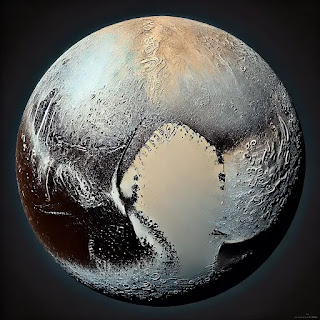In the realm of space exploration, few missions have captivated the public's imagination like NASA's New Horizons mission. Launched in 2006, New Horizons provided humanity with its first close-up look at Pluto in 2015. Recently, NASA released new photos from this distant dwarf planet, revealing even more fascinating details about its surface and atmosphere. Let's dive into the latest discoveries and what they mean for our understanding of Pluto.
Pluto, once considered the ninth planet in our solar system, was reclassified as a dwarf planet in 2006. Despite this, Pluto remains an object of great interest to astronomers and the public alike. The New Horizons mission marked the first-ever flyby of Pluto, providing unprecedented images and data about this distant world.
The Latest Photos: What Do They Show?
1. Striking Surface Features
The new images reveal an even more detailed view of Pluto's
diverse and complex surface. One of the most striking features is the
heart-shaped region known as Tombaugh Regio. Named after Pluto's discoverer,
Clyde Tombaugh, this area is divided into two distinct lobes: Sputnik Planitia,
a vast nitrogen ice plain, and the more rugged, cratered terrain of Cthulhu
Macula.
- Sputnik
Planitia: The new photos show intricate patterns of convection cells
on this nitrogen ice plain, indicating dynamic processes beneath the
surface. These cells are thought to be formed by the slow movement of
nitrogen ice, driven by heat from Pluto's interior.
- Cthulhu
Macula: This darker region displays more craters, suggesting an older
surface. The new images provide clearer views of the rugged terrain,
revealing a landscape shaped by impacts and possibly ancient volcanic
activity.
2. Mysterious Atmospheric Haze
Another fascinating discovery from the new photos is the
detailed structure of Pluto's atmosphere. New Horizons had previously detected
a thin atmosphere composed mainly of nitrogen, with traces of methane and
carbon monoxide. The latest images show multiple layers of atmospheric haze,
extending up to 200 kilometers above the surface.
- Haze
Layers: The haze appears to be formed by complex organic molecules,
known as tholins, created by the interaction of sunlight with methane in
Pluto's atmosphere. These layers give Pluto's sky a blue tint when viewed in
certain lighting conditions.
- Surface-Atmosphere
Interaction: The presence of such a layered atmosphere suggests active
surface-atmosphere interactions. Seasonal changes in sunlight might drive the
sublimation and deposition of ices, influencing both surface and
atmospheric dynamics.
One of the most intriguing findings in the new photos is the
potential evidence for cryovolcanism on Pluto. Cryovolcanism, or ice volcanism,
involves the eruption of volatile substances like water, ammonia, or methane,
instead of molten rock.
- Wright
Mons and Piccard Mons: The new images provide clearer views of these
large mountainous features, which some scientists believe could be
cryovolcanoes. These formations have central depressions and appear to be
surrounded by flows, suggesting past volcanic activity that brought
subsurface materials to the surface.
What Do These Discoveries Mean?
The latest photos from New Horizons continue to challenge
and expand our understanding of Pluto. Here are some key implications of these
discoveries:
1. A Geologically Active World
The detailed images of Pluto's surface and atmosphere reveal
a world that is far from static. The presence of convection cells, atmospheric
haze, and potential cryovolcanism indicates that Pluto is geologically active,
with processes that continue to shape its landscape.
2. Complex Climate and Weather Patterns
The multiple haze layers and their interactions with the
surface suggest complex climate and weather patterns on Pluto. Understanding
these patterns could provide insights into similar processes on other icy
bodies in the outer solar system, such as Neptune's moon Triton.
3. Implications for Planetary Science
The discoveries on Pluto have broader implications for
planetary science. They highlight the importance of continued exploration of
the outer solar system, where many worlds remain largely unexplored. Missions
like New Horizons pave the way for future exploration, helping us understand the
diversity and complexity of our solar system.
NASA's latest photos from Pluto have brought to light a wealth of new information, revealing a dynamic and complex world that continues to surprise scientists. From its active surface to its layered atmosphere, Pluto proves that even the most distant objects in our solar system can hold secrets that challenge our understanding of planetary science. As we look forward to future missions and discoveries, Pluto remains a fascinating frontier, reminding us of the endless possibilities in our quest to explore the cosmos.
Stay tuned to www.kinetickine.com for more updates on space exploration and other exciting scientific discoveries. Together, we are going to make it our goal to reach the stars in the future.








0 Comments:
Post a Comment